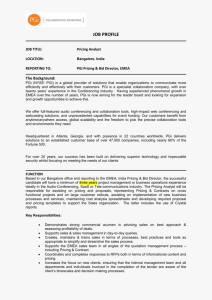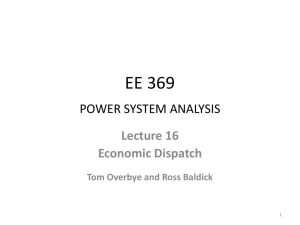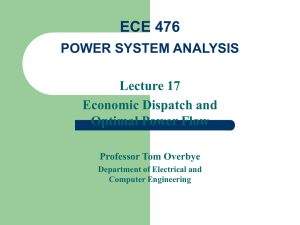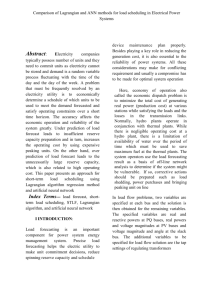Economic Dispatch and Optimal Power Flow
advertisement
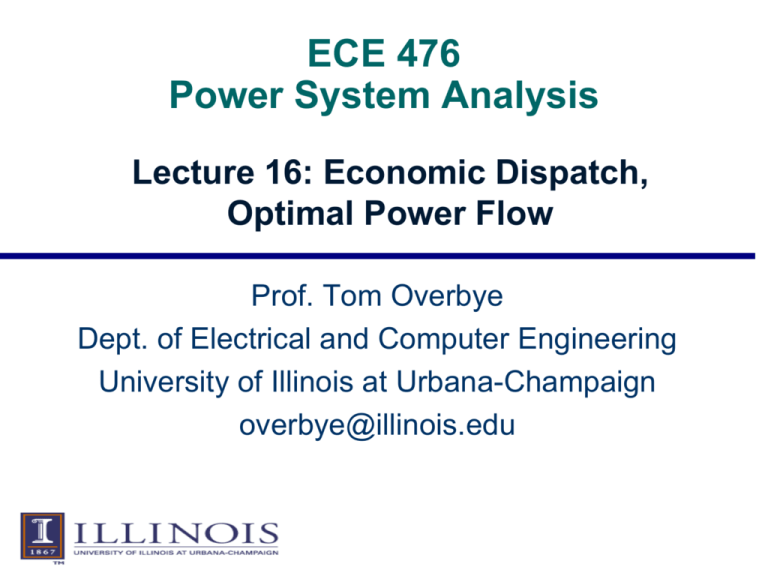
ECE 476 Power System Analysis Lecture 16: Economic Dispatch, Optimal Power Flow Prof. Tom Overbye Dept. of Electrical and Computer Engineering University of Illinois at Urbana-Champaign overbye@illinois.edu Announcements • Chapter 12.4 and 12.5, Chapter 7 • HW 7 is due now • HW 8 is 12.19, 12.20, 12.26, 12.28; due October 29 in class (no quiz) 1 Economic Dispatch Lagrangian For the economic dispatch we have a minimization constrained with a single equality constraint L(PG , ) m m Ci ( PGi ) ( PD PGi ) i 1 (no losses) i 1 The necessary conditions for a minimum are L(PG , ) dCi ( PGi ) 0 (for i 1 to m) PGi dPGi m PD PGi 0 i 1 2 Economic Dispatch Example What is economic dispatch for a two generator system PD PG1 PG 2 500 MW and C1 ( PG1 ) 1000 20 PG1 0.01PG21 $ / hr C2 ( PG 2 ) 400 15 PG 2 0.03PG22 $ / hr Using the Largrange multiplier method we know dC1 ( PG1 ) dPG1 20 0.02 PG1 0 dC2 ( PG 2 ) dPG 2 15 0.06 PG 2 0 500 PG1 PG 2 0 3 Economic Dispatch Example, cont’d We therefore need to solve three linear equations 20 0.02 PG1 0 15 0.06 PG 2 0 500 PG1 PG 2 0 0 1 PG1 20 0.02 0 0.06 1 PG 2 15 1 1 500 PG1 312.5 MW P 187.5 MW G2 26.2 $/MWh 4 Lambda-Iteration Solution Method • The direct solution only works well if the incremental cost curves are linear and no generators are at their limits • A more general method is known as the lambdaiteration – – the method requires that there be a unique mapping between a value of lambda and each generator’s MW output the method then starts with values of lambda below and above the optimal value, and then iteratively brackets the optimal value 5 Lambda-Iteration Algorithm Pick L and H such that m L P ( Gi ) PD 0 H P ( Gi ) PD 0 i=1 i=1 While m H L Do M ( H L ) / 2 m If M H M P ( ) P 0 Then Gi D i=1 Else L M End While 6 Lambda-Iteration: Graphical View In the graph shown below for each value of lambda there is a unique PGi for each generator. This relationship is the PGi() function. 7 Lambda-Iteration Example Consider a three generator system with IC1 ( PG1 ) 15 0.02 PG1 $/MWh IC2 ( PG 2 ) 20 0.01PG 2 $/MWh IC3 ( PG 3 ) 18 0.025 PG 3 $/MWh and with constraint PG1 PG 2 PG 3 1000 MW Rewriting as a function of , PGi ( ), we have PG1 ( ) 15 0.02 18 PG3 ( ) 0.025 PG2 ( ) 20 0.01 8 Lambda-Iteration Example, cont’d Pick L so m L P ( Gi ) 1000 0 and i=1 m H P ( Gi ) 1000 0 i=1 Try L 20 then m PGi (20) 1000 i 1 15 20 18 0.02 0.01 Try H 30 then 0.025 m 1000 670 MW PGi (30) 1000 i 1 1230 MW 9 Lambda-Iteration Example, cont’d Pick convergence tolerance 0.05 $/MWh Then iterate since H L 0.05 M ( H L ) / 2 25 m Then since H P (25) 1000 280 we set 25 Gi i 1 Since 25 20 0.05 M (25 20) / 2 22.5 m L P (22.5) 1000 195 we set 22.5 Gi i 1 10 Lambda-Iteration Example, cont’d Continue iterating until 0.05 H L The solution value of , * , is 23.53 $/MWh Once * is known we can calculate the PGi 23.53 15 PG1 (23.5) 426 MW 0.02 23.53 20 PG2 (23.5) 353 MW 0.01 23.53 18 PG3 (23.5) 221 MW 0.025 11 Generator MW Limits • Generators have limits on the minimum and maximum amount of power they can produce • Often times the minimum limit is not zero. This represents a limit on the generator’s operation with the desired fuel type • Because of varying system economics usually many generators in a system are operated at their maximum MW limits. 12 Lambda-Iteration with Gen Limits In the lambda-iteration method the limits are taken into account when calculating PGi ( ) : if PGi ( ) PGi ,max then PGi ( ) PGi ,max if PGi ( ) PGi ,min then PGi ( ) PGi ,min 13 Lambda-Iteration Gen Limit Example In the previous three generator example assume the same cost characteristics but also with limits 0 PG1 300 MW 100 PG2 500 MW 200 PG3 600 MW With limits we get m PGi (20) 1000 i 1 PG1 (20) PG 2 (20) PG 3 (20) 1000 250 100 200 450 MW (compared to -670MW) m PGi (30) 1000 i 1 300 500 480 1000 280 MW 14 Lambda-Iteration Limit Example,cont’d Again we continue iterating until the convergence condition is satisfied. With limits the final solution of , is 24.43 $/MWh (compared to 23.53 $/MWh without limits). The presence of limits will always cause to either increase or remain the same. Final solution is PG1 (24.43) 300 MW PG2 (24.43) 443 MW PG3 (24.43) 257 MW 15 Back of Envelope Values • Often times incremental costs can be approximated by a constant value: – – – – $/MWhr = fuelcost * heatrate + variable O&M Typical heatrate for a coal plant is 10, modern combustion turbine is 10, combined cycle plant is 7 to 8, older combustion turbine 15. Fuel costs ($/MBtu) are quite variable, with current values around 1.5 for coal, 4 for natural gas, 0.5 for nuclear, probably 10 for fuel oil. Hydro, solar and wind costs tend to be quite low, but for this sources the fuel is free but limited 16 Inclusion of Transmission Losses • The losses on the transmission system are a function of the generation dispatch. In general, using generators closer to the load results in lower losses • This impact on losses should be included when doing the economic dispatch • Losses can be included by slightly rewriting the Lagrangian: L(PG , ) m m i 1 i 1 Ci ( PGi ) ( PD PL ( PG ) PGi ) 17 Impact of Transmission Losses This small change then impacts the necessary conditions for an optimal economic dispatch L(PG , ) m m i 1 i 1 Ci ( PGi ) ( PD PL ( PG ) PGi ) The necessary conditions for a minimum are now L(PG , ) PGi dCi ( PGi ) PL ( PG ) (1 )0 dPGi PGi m PD PL ( PG ) PGi 0 i 1 18 Impact of Transmission Losses Solving each equation for we get dCi ( PGi ) PL ( PG ) (1 0 dPGi PGi dCi ( PGi ) 1 PL ( PG ) dPGi 1 P Gi Define the penalty factor Li for the i th generator 1 Li PL ( PG ) 1 P Gi The penalty factor at the slack bus is always unity! 19 Impact of Transmission Losses The condition for optimal dispatch with losses is then L1IC1 ( PG1 ) L2 IC2 ( PG 2 ) Lm ICm ( PGm ) 1 Since Li if increasing PGi increases PL ( PG ) 1 P Gi PL ( PG ) the losses then 0 Li 1.0 PGi This makes generator i appear to be more expensive (i.e., it is penalized). Likewise Li 1.0 makes a generator appear less expensive. 20 Calculation of Penalty Factors Unfortunately, the analytic calculation of Li is somewhat involved. The problem is a small change in the generation at PGi impacts the flows and hence the losses throughout the entire system. However, using a power flow you can approximate this function by making a small change to PGi and then seeing how the losses change: PL ( PG ) PL ( PG ) PGi PGi 1 Li PL ( PG ) 1 PGi 21 Two Bus Penalty Factor Example PL ( PG ) 0.0387 PG 2 L2 0.9627 PL ( PG ) 0.37 MW 0.037 PGi 10MW L2 0.9643 22 Thirty Bus ED Example • Case is economically dispatched without considering the incremental impact of the system losses 23 Thirty Bus ED Example, cont • Because of the penalty factors the generator incremental costs are no longer identical. 24 Area Supply Curve • The area supply curve shows the cost to produce the next MW of electricity, assuming area is economically dispatched 10.00 7.50 Supply curve for thirty bus system 5.00 2.50 0.00 0 100 200 Total Area Generation (MW) 300 400 25 Economic Dispatch - Summary • Economic dispatch determines the best way to minimize the current generator operating costs • The lambda-iteration method is a good approach for solving the economic dispatch problem – – generator limits are easily handled penalty factors are used to consider the impact of losses • Economic dispatch is not concerned with determining which units to turn on/off (this is the unit commitment problem) • Economic dispatch ignores the transmission system limitations 26 Optimal Power Flow • The goal of an optimal power flow (OPF) is to determine the “best” way to instantaneously operate a power system. • Usually “best” = minimizing operating cost. • OPF considers the impact of the transmission system • OPF is used as basis for real-time pricing in major US electricity markets such as MISO and PJM. • ECE 476 introduces the OPF problem and provides some demonstrations. 27 Electricity Markets • Over last fifteen years electricity markets have moved from bilateral contracts between utilities to also include spot markets (day ahead and realtime). • Electricity (MWh) is now being treated as a commodity (like corn, coffee, natural gas) with the size of the market transmission system dependent. • Tools of commodity trading are being widely adopted (options, forwards, hedges, swaps). 28 Electricity Futures Example Source: Wall Street Journal Online, 10/21/2015 29 Historical Variation in Oct 2015 Price Price has dropped, following the drop in natural gas prices Source: Wall Street Journal Online, 10/21/2015 “Ideal” Power Market • Ideal power market is analogous to a lake. Generators supply energy to lake and loads remove energy. • Ideal power market has no transmission constraints • Single marginal cost associated with enforcing constraint that supply = demand – – buy from the least cost unit that is not at a limit this price is the marginal cost • This solution is identical to the economic dispatch problem solution 31 Two Bus Economic Dispatch Example Total Hourly Cost : 8459 $/hr Area Lambda : 13.02 Bus A Bus B 300.0 MW 199.6 MW AGC ON 300.0 MW 400.4 MW AGC ON 32 Market Marginal (Incremental) Cost Below are some graphs associated with this two bus system. The graph on left shows the marginal cost for each of the generators. The graph on the right shows the system supply curve, assuming the system is optimally dispatched. 16.00 16.00 15.00 15.00 14.00 14.00 13.00 13.00 12.00 12.00 0 175 350 525 Generator Power (MW) 700 0 350 Current generator operating point 700 1050 Total Area Generation (MW) 1400 33 Real Power Markets • Different operating regions impose constraints -total demand in region must equal total supply • Transmission system imposes constraints on the market • Marginal costs become localized • Requires solution by an optimal power flow 34 Optimal Power Flow (OPF) • OPF functionally combines the power flow with economic dispatch • Minimize cost function, such as operating cost, taking into account realistic equality and inequality constraints • Equality constraints – – – bus real and reactive power balance generator voltage setpoints area MW interchange 35 OPF, cont’d • Inequality constraints – – – – transmission line/transformer/interface flow limits generator MW limits generator reactive power capability curves bus voltage magnitudes (not yet implemented in Simulator OPF) • Available Controls – – generator MW outputs transformer taps and phase angles 36



